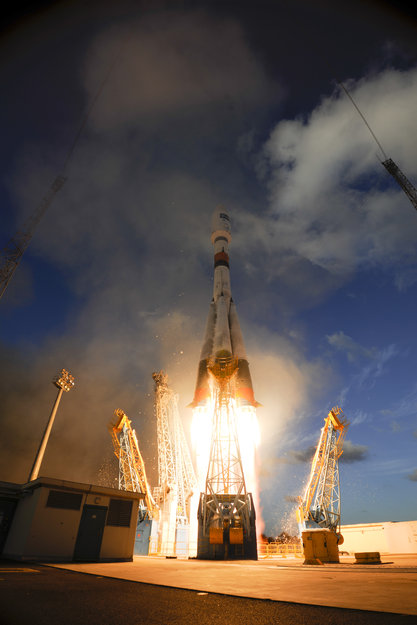Sentinel-1 performs opening dance routine
Following its launch yesterday, Sentinel-1A has performed a carefully choreographed 10-hour dance routine to open its large radar antenna and solar wings.
During the launch, the 12 m-long radar and two 10 m-long solar wings were folded up to fit into the protective Soyuz rocket fairing.
After being lofted to 693 km above Earth and released into orbit, the satellite gently ‘tumbled’ to stabilise before embarking on its elaborate dance routine.
The solar wings and radar opened together in a specific sequence that took around 10 hours to complete. As one of most critical stages in the life of the mission, it was choreographed to ensure that both deploy in the safest possible way.
The sequence also allowed power from the wings to be available as soon as possible so that the satellite was independent.
ESA’s Sentinel-1 Project Manager, Ramón Torres, said, “This crucial and complex deployment sequence was analysed and dissected over and over again during the design phase.
"It was tested with perfect results in last month, but it is still a magic moment to know that it has happened in the sky.
“We now very much look forward to the end of the launch and early orbit phase planned for the coming Sunday, and then commissioning the satellite for operations.
“It is reassuring to know that our precious satellite in the safe hands of our colleagues at the European Space Operations Centre in Germany."

Soyuz VS07 with the ESA’s Sentinel-1A satellite lifted off from Europe’s Spaceport in Kourou, French Guiana, on 3rd April 2014.
Sentinel-1A – the first satellite built for the Copernicus environmental monitoring programme – will be used to monitor many aspects of our environment, from detecting and tracking oil spills and mapping sea ice to monitoring movement in land surfaces and mapping changes in the way land is used. It will also play a crucial role in providing timely information to help respond to natural disasters and assist humanitarian relief efforts.
Sentinel-1A liftoff

Soyuz VS07 with the ESA’s Sentinel-1A satellite lifted off from Europe’s Spaceport in Kourou, French Guiana, on 3rd April 2014.
Sentinel-1A – the first satellite built for the Copernicus environmental monitoring programme – will be used to monitor many aspects of our environment, from detecting and tracking oil spills and mapping sea ice to monitoring movement in land surfaces and mapping changes in the way land is used. It will also play a crucial role in providing timely information to help respond to natural disasters and assist humanitarian relief efforts.
LAUNCH:
Sentinel-1A was launched on 3 April 2014 on a Russian Soyuz rocket from Europe’s Spaceport near Kourou in French Guiana, an overseas department of France.
The Soyuz launcher is the workhorse of the Russian space programme, in continuous production since the 1960s, and a descendant in design terms of the R-7 rocket that launched Sputnik in 1957, inaugurating the Space Age.
Soyuz has performed more than 1700 manned and unmanned missions. It is designed to extremely high reliability levels for manned missions – today supporting operations of the International Space Station.
The Soyuz-2 version used at Europe’s Spaceport is Soyuz-ST. This three-stage rocket (plus Fregat upper stage) is assembled horizontally in the traditional Russian approach, then moved to the vertical so that its payload can be mated from above in the standard European way.
ESAGuillermo Gonzalo Sánchez Achutegui
ayabaca@gmail.com
ayabaca@hotmail.com
ayabaca@yahoo.com
Inscríbete en el Foro del blog y participa : A Vuelo De Un Quinde - El Foro!


No hay comentarios:
Publicar un comentario